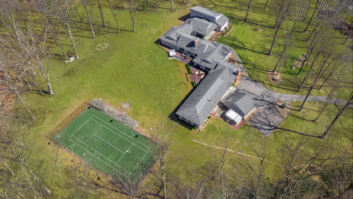

Producer/songwriters David Gamson (Miles Davis, Meshell Ndegeocello, Chaka Khan) and Oliver Leiber (The Corrs, Aretha Franklin, Paula Abdul) have collaborated on many projects, from scoring cues for Mission Impossible II to producing records for Ricky Martin. Their process is to track and overdub at Leiber’s Hollywood Hills studio and complete editing and programming at Gamson’s Mechanism Studios (L.A.).
Spare bedroom turned recording outlet: Mechanism Studio.
photo: David Gamson
However, Gamson moved to a home in Long Beach, Calif., and was midway through massive renovations. He decided to move Mechanism to a nearby commercial property, but it wouldn’t be ready for about nine months. Needing an interim studio space, Gamson assembled his absolute necessities for recording (a Nuendo rig, preamps, converters, Genelec monitors, etc.) into a spare 11×11-foot bedroom. It was far from ideal, but he could finish editing and mixing in this space. “I gave my temporary setup a ‘test drive’ during some songwriting sessions and it was horrible,” laments Gamson. “With all of the reflections, it was hard to hear imaging at the mix position, and the bass wandered around the room.”
In small rooms, most acoustic problems involve interaction of strong sound reflections between surfaces, creating the cancellation of sounds at certain frequencies and hotspots at other frequencies. Gamson e-mailed pictures of the room and a floor plan to Auralex Acoustics’ regional manager Rusty Sulzmann, who returned an architectural drawing specifying the type and placement of the company’s diffusers, absorbers and corner treatment products.
“In a small room such as David’s, axial modes and standing waves are largely one and the same,” Sulzmann says. Gamson’s bass complaints at the mix position were caused by the first-floor ceiling axial mode at 70 Hz — close to an open D-string on a bass guitar — and a front-to-back axial mode at 49 Hz, low G on a bass guitar.
“For the 70Hz mode, deeper bass traps above the mix position would help, but the space required might occupy more headroom than David is willing to sacrifice,” Sulzmann continues. “The quickest way to cure this is to space the ProFusors down about six inches from the ceiling and treat behind them with 4-inch Studiofoam or several layers of SonoFiber.” For the 49Hz mode, Auralex CT45 panels on the rear wall could help, but opening the rear double doors during mixdown would provide extra “breathing room” for the bass.

Oliver Leiber and david Gamson
photo: David Gamson
Auralex Acoustics designs and builds studios through its network of worldwide representative companies. Local custom installer Nigel Martinez — who runs NJM, a one-man studio design operation in Southern California — accomplished Mechanism’s “studio makeover” in one day.
“You address all the frequencies you’re going to hear in the room to make it as pleasant and accurate as possible,” Martinez says. “This room required a lot of bass trapping in the corners because of all the bass buildup in that small space. In a home setup with near-fields, you have to adjust the mix position to accommodate the room. In David’s room, that position is in the exact middle — maybe not the most ergonomic spot, but the best place for the most accurate monitoring.”
Each of the four corners uses LENRD (Low-End Node-Reduction Device) bass traps behind B-24 absorption panels set off by at least two inches of air space. Sound vibrations go through the panel and get lost in the air space, with lower frequencies absorbed by the LENRD. “The ceiling treatment above the mix position is made up of our ProFusor panels,” Martinez continues. “In small rooms, diffusion is sometimes preferred above the mix position, as too much absorption can pull too much life out of a room.”
The end result is a neutral and balanced-sounding room that’s great for overdubs. “I was concerned I’d end up with a very lifeless-sounding room,” Gamson says, “but now I’m surprised how much more open and clear everything sounds. There is better imaging at the mix position, with no flutter echoes or bass problems.”
Barry Rudolph is an L.A.-based recording engineer. Visit him at
www.barryrudolph.com.


An ergonomic nightmare: Mechanism Studios before Auralex and Nigel Martinez’s NJM Media stepped in.
Click here to view the architectural drawing of the new Mechanism Studios, designed by Auralex Acoustics regional manager Rusty Sulzmann.







